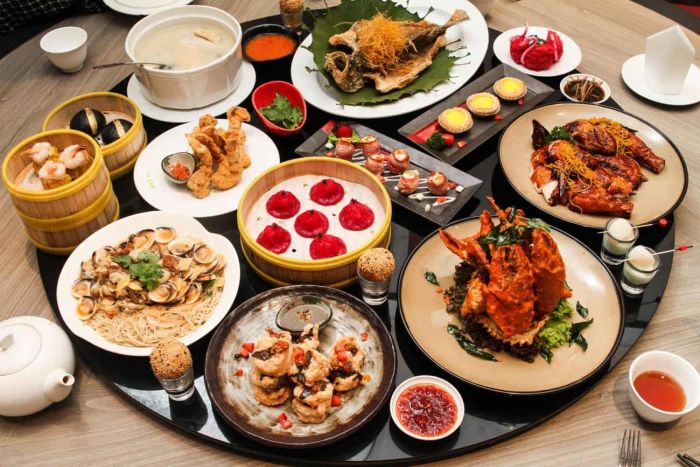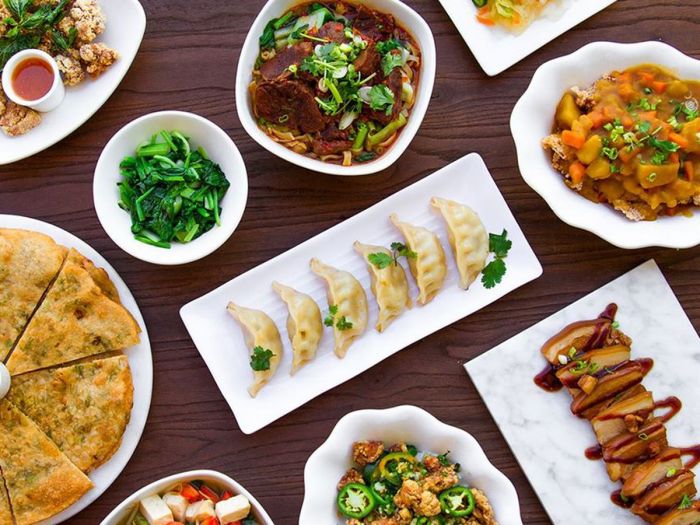Chinese language meals mandarin space – Welcome to the world of Chinese language meals from the Mandarin space, the place culinary delights dance in your palate and tantalize your senses. This vibrant delicacies, born within the coronary heart of China, has captivated style buds for hundreds of years, boasting a wealthy tapestry of flavors, methods, and traditions that proceed to enchant diners right this moment.
From the bustling streets of Beijing to the serene landscapes of Shandong, the Mandarin space has nurtured a culinary heritage that’s as various as it’s scrumptious. Be a part of us as we discover the fascinating flavors, famend dishes, and culinary improvements that outline this beloved delicacies.
Mandarin Space in Chinese language Delicacies
The Mandarin space, encompassing northern and southwestern China, holds a pivotal place within the culinary panorama of the nation. Its delicacies, often called Mandarin delicacies, is a wealthy tapestry of flavors, methods, and cultural influences which have formed its distinct character.
Traditionally, the Mandarin space was a hub of political and financial exercise, with main cities like Beijing and Xi’an serving as imperial capitals. This cosmopolitan atmosphere fostered a vibrant alternate of culinary concepts and methods, resulting in the event of a complicated and various delicacies.
Cultural and Historic Influences
Mandarin delicacies displays the cultural and historic influences of the area. The emphasis on wheat cultivation in northern China led to the prominence of noodles and dumplings within the delicacies. The southwestern area, with its abundance of spices and herbs, contributed a definite taste profile to Mandarin dishes.
Standard Dishes
A number of the hottest dishes originating from the Mandarin space embrace:
- Peking Duck: A succulent roasted duck served with skinny pancakes, hoisin sauce, and scallions.
- Kung Pao Rooster: A spicy stir-fried dish that includes hen, peanuts, and greens.
- Beijing Zhajiangmian: Noodles topped with a savory fermented soybean paste sauce.
Key Traits of Mandarin Delicacies
Mandarin delicacies, originating from the northern provinces of China, is famend for its distinctive flavors and cooking methods. This regional delicacies has gained widespread reputation each inside China and internationally, characterised by its emphasis on recent components, delicate seasonings, and a fragile steadiness of flavors.
Mandarin dishes are sometimes characterised by their mild and refreshing flavors, with a deal with preserving the pure style of the components. Soy sauce, vinegar, and sesame oil are generally used as seasonings, together with a wide range of fragrant greens akin to garlic, ginger, and scallions.
Wheat-based merchandise, akin to noodles and dumplings, are additionally outstanding in Mandarin delicacies.
Cooking Strategies
Mandarin delicacies employs numerous cooking methods to attain its distinct flavors. Steaming, stir-frying, and boiling are generally used strategies, permitting for the preservation of vitamins and flavors. Steaming is commonly used for delicate dishes akin to fish and greens, whereas stir-frying is employed for creating fragrant and flavorful dishes with a barely crispy texture.
Boiling is used for soups, stews, and noodles.
Comparability with Different Regional Cuisines
Mandarin delicacies differs from different regional Chinese language cuisines in a number of facets. In comparison with Cantonese delicacies, which is thought for its emphasis on seafood and light-weight sauces, Mandarin delicacies usually incorporates extra wheat-based merchandise and has a barely stronger taste profile.
Sichuan delicacies, then again, is famend for its spicy and pungent flavors, whereas Mandarin delicacies is usually milder when it comes to spiciness.
Well-known Eating places and Cooks within the Mandarin Space

Mandarin delicacies has captivated the world with its refined flavors and beautiful shows. This part delves into the famend eating places and celebrated cooks who’ve elevated the artwork of Mandarin culinary arts to new heights.
Famend Eating places
- Da Dong Peking Roast Duck Restaurant:Famend for its crispy Peking duck, this restaurant has gained worldwide acclaim. Its Peking duck is ready in response to centuries-old traditions, leading to a succulent and flavorful dish.
- Quanjude Roast Duck Restaurant:One other legendary institution specializing in Peking duck. Quanjude has been serving its signature dish for over a century, attracting patrons from across the globe.
- Yi Palace:This fine-dining restaurant provides a complicated ambiance and a menu that showcases one of the best of Mandarin delicacies. Yi Palace is thought for its modern dishes that mix conventional flavors with fashionable methods.
Distinguished Cooks
- Chef Dong Zhenxiang:A famend grasp chef specializing in Peking duck. Chef Dong’s meticulous consideration to element and mastery of conventional methods have earned him widespread recognition.
- Chef Li Jianguo:A culinary innovator who has performed a pivotal function in selling Mandarin delicacies internationally. Chef Li’s dishes showcase the flexibility of Mandarin flavors, mixing custom with creativity.
- Chef Wang Zhihe:A revered chef recognized for his experience in Shandong delicacies, a regional model that closely influences Mandarin delicacies. Chef Wang’s dishes are characterised by their daring flavors and hearty components.
These eating places and cooks characterize the top of Mandarin culinary excellence, providing distinctive eating experiences that commemorate the wealthy heritage and modern spirit of this beloved delicacies.
Trendy Interpretations of Mandarin Delicacies

Mandarin delicacies, famend for its wealthy historical past and distinct flavors, has undergone a transformative journey in current instances, adapting to the evolving palates and culinary tendencies of the fashionable period. Revolutionary cooks and restaurateurs are pushing the boundaries of conventional Mandarin delicacies, mixing traditional flavors with modern influences to create dishes which might be each acquainted and refreshingly novel.
Molecular Gastronomy
Molecular gastronomy, a scientific method to cooking, has made vital inroads into Mandarin delicacies. Cooks are experimenting with methods akin to spherification, emulsification, and sous vide to create dishes that problem typical textures and shows. For instance, Peking duck can now be offered as a crispy sphere stuffed with succulent duck meat, accompanied by a fragile foam constructed from the duck’s juices.
Fusion Delicacies, Chinese language meals mandarin space
Mandarin delicacies can be embracing fusion, mixing conventional Chinese language flavors with components from different culinary traditions. Western components akin to truffle oil, balsamic vinegar, and foie gras are being integrated into traditional dishes, making a harmonious interaction of flavors. For example, stir-fried lobster could also be enhanced with a contact of truffle oil, whereas Peking duck might be served with a balsamic glaze.
Sustainability and Well being
Trendy interpretations of Mandarin delicacies additionally mirror a rising emphasis on sustainability and well being. Cooks are utilizing regionally sourced components, decreasing waste, and incorporating extra plant-based choices into their menus. Steamed fish with greens is a well-liked alternative, as is tofu stir-fried with seasonal greens.
Presentation and Aesthetics
Presentation has turn into an integral facet of contemporary Mandarin delicacies. Cooks are paying meticulous consideration to the visible attraction of their dishes, utilizing vibrant colours, intricate garnishes, and stylish plating. This deal with aesthetics enhances the eating expertise, making every dish a feast for each the eyes and the palate.
Well being and Dietary Points of Mandarin Delicacies

Mandarin delicacies is famend for its health-conscious method, emphasizing recent, seasonal components and balanced flavors. Let’s delve into the dietary worth and well being implications of Mandarin dishes.
Mandarin dishes are usually low in fats and energy, making them appropriate for weight administration. They’re additionally wealthy in nutritional vitamins, minerals, and antioxidants, which contribute to total well being and well-being.
Dietary Worth
- Greens:Mandarin delicacies incorporates an abundance of greens, offering fiber, nutritional vitamins (A, C, Okay), and minerals (potassium, magnesium).
- Lean Proteins:Fish, poultry, and tofu are frequent protein sources in Mandarin dishes, providing important amino acids and low saturated fats.
- Entire Grains:Brown rice, noodles, and dumplings present advanced carbohydrates, fiber, and B nutritional vitamins.
- Wholesome Fat:Mandarin dishes usually use plant-based oils (e.g., canola, sesame) wealthy in unsaturated fat, useful for coronary heart well being.
Well being Advantages
- Diminished Danger of Persistent Illnesses:The excessive consumption of greens and antioxidants might assist scale back the chance of coronary heart illness, stroke, and sure forms of most cancers.
- Improved Digestion:Fiber from greens and complete grains promotes wholesome digestion and prevents constipation.
- Boosted Immunity:Vitamin C and antioxidants in Mandarin dishes help a wholesome immune system.
Potential Dangers
- Sodium Consumption:Some Mandarin dishes could also be excessive in sodium, which might contribute to hypertension in delicate people.
- Monosodium Glutamate (MSG):MSG, a taste enhancer generally utilized in Mandarin delicacies, might set off hostile reactions in some folks, akin to complications and nausea.
Incorporating Mandarin Delicacies right into a Balanced Food regimen
To benefit from the well being advantages of Mandarin delicacies whereas minimizing potential dangers, think about the next suggestions:
- Select dishes with loads of greens and lean protein.
- Go for complete grains over refined carbohydrates.
- Request low-sodium choices when eating out.
- Restrict dishes with added MSG or select MSG-free choices.
- Mix Mandarin dishes with different meals teams (e.g., fruits, dairy) for a balanced meal.
FAQ Defined: Chinese language Meals Mandarin Space
What are the important thing traits of Mandarin delicacies?
Mandarin delicacies is thought for its emphasis on recent components, mild sauces, and delicate flavors. It usually options dishes which might be steamed, stir-fried, or roasted, preserving the pure flavors of the components.
What are some standard dishes from the Mandarin space?
A number of the most well-known dishes from the Mandarin space embrace Peking duck, Kung Pao hen, and Zhajiangmian (noodles with soybean paste sauce).
How has Mandarin delicacies developed over time?
Mandarin delicacies has developed to mirror altering tastes and influences, incorporating fashionable methods and components whereas preserving conventional flavors and cooking strategies.



